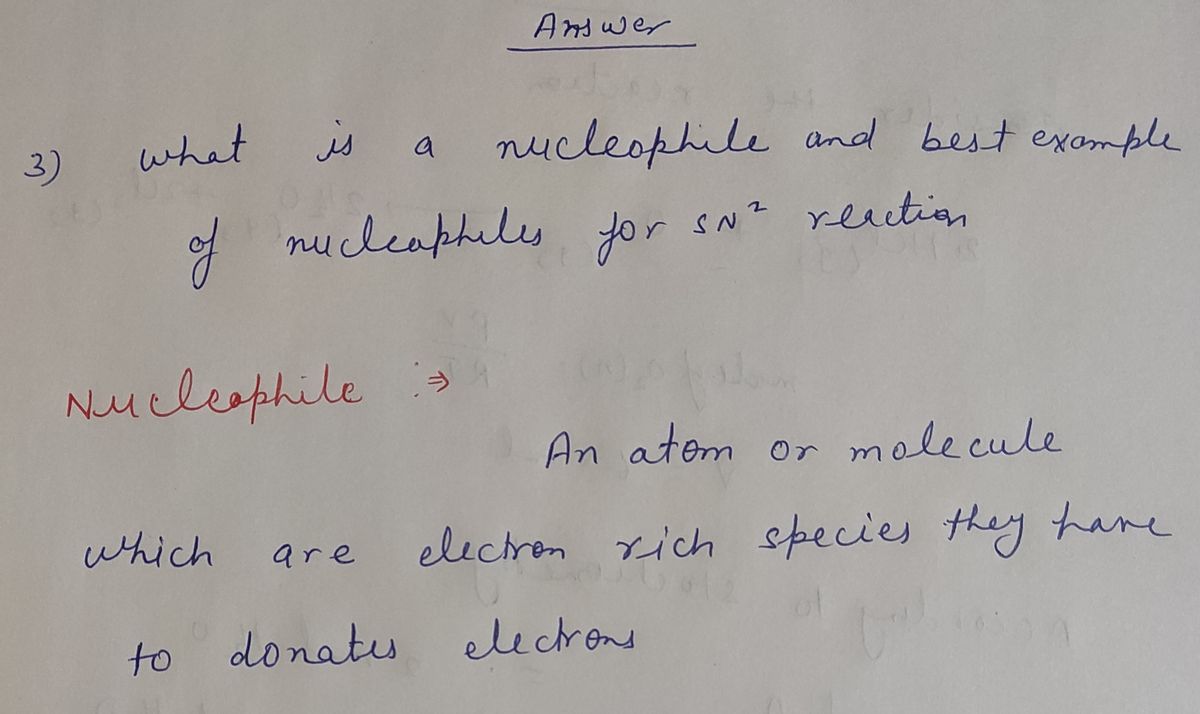
Chemistry
10th Edition
ISBN: 9781305957404
Author: Steven S. Zumdahl, Susan A. Zumdahl, Donald J. DeCoste
Publisher: Cengage Learning
expand_more
expand_more
format_list_bulleted
Question

Transcribed Image Text:### Understanding Nucleophiles in SN2 Reactions
Nucleophiles are chemical species that donate an electron pair to form a chemical bond in relation to a reaction. A strong nucleophile is essential for SN2 (bimolecular nucleophilic substitution) reactions because it directly attacks the electrophilic center, leading to a concerted reaction mechanism.
#### Key Characteristics of a Nucleophile:
- **Electron-rich**: Nucleophiles have lone pair electrons or negative charges that make them electron-rich and ready to donate electrons.
- **Strong Bases**: Many nucleophiles are also strong bases, although not all strong bases are good nucleophiles.
- **Small in Size**: Smaller nucleophiles can more easily approach and attack the electrophile.
#### Examples of Nucleophiles for SN2 Reactions:
- **Hydroxide Ion (OH⁻)**: Common in many reactions due to its negative charge and ability to donate electrons readily.
- **Alkoxide Ions (RO⁻)**: Similar to hydroxide ions but with an organic substituent (R group).
- **Halide Ions (Cl⁻, Br⁻, I⁻)**: Particularly bromide and iodide ions are effective in SN2 reactions due to their size and stability.
- **Ammonia (NH₃)** and **Amines (RNH₂, R₂NH)**: These species can donate a lone pair from the nitrogen atom.
#### Mechanism:
In an SN2 reaction, the nucleophile attacks the electrophilic carbon atom from the opposite side of the leaving group, resulting in a one-step mechanism where bonds are formed and broken simultaneously.
Understanding the role and examples of nucleophiles can significantly impact the efficiency and outcome of chemical reactions, especially in organic synthesis.
Expert Solution
arrow_forward
Step 1

Step by stepSolved in 2 steps with 2 images

Knowledge Booster
Similar questions
- CANNOT BE HAND-WRITTENarrow_forwardQuestion 13 of 28 Fill in the blanks: Professor Lolita Carbon has assigned the analysis of unknown hydrocarbon samples to Enteng Mabutingting based on their reaction profile. The summary of the observed reactions are tabulated below along with the possible structures of the samples. Identify each unknown sample by matching the respective reaction profile with the given structures. Name each structure. Sample 1 2 3 H3C. H3C Br₂ in CCl4 (dark) Fading of reddish-brown color Fading of reddish-brown CH3 No reaction 1 A Complete the table below. Sample 2 color 3 CH3 Br₂ in CCl4 (light) Fading of reddish- brown color Fading of reddish- brown color Fading of reddish- brown color H₂C B B Compound (Letters only) C CH3 5-diyne KMnO4 in NaOH No reaction Brown precipitates Brown precipitates H₂C C AgNO3 in NH3 No reaction No reaction Silver precipitates CH3 Name 1-ethyl cycloh hexa-1 Aarrow_forwardThis molecule reacts with HBr to form an alkyl halide. Would this reaction be sn1 or Sn2 and explain the reasoningarrow_forward
- 6) The substitution reaction below to produce 1-iodobutane was performed using 1-bromobutane at a 0.1 M concentration and sodium iodide at a 0.1 M concentration. What would the rate law be for the reaction below? How would you expect the rate of the reaction to change if a 0.2 M concentration of sodium iodide was used? How would you expect the rate constant to change? Explain. Nal (0.1 M) Br acetone (0.1 M)arrow_forwardNucleophilic Substitution and Elimination. A Worksheet Lab. Pre-Lab 1. Identify the following organic transformations. Are they "substitutions" or "additions" or "eliminations"? Write formulas that clearly illustrate you selection. Pay attention to the organic part of the transformations. Example. Br ultraviolet light HBr + Br₂ formulas: CsH12 Br2 CsH11Br HBr This is a "substitution" reaction. H has been replaced (substituted) by Brarrow_forwardThe compound below is treated with chlorine in the presence of light. H₂C CH3 H₂C CH3 Draw the structure for the organic radical species produced by reaction of the compound with a chlorine atom. Assume reaction occurs at the weakest C-H bond. You do not have to consider stereochemistry. • You do not have to explicitly draw H atoms. Undoarrow_forward
- The compound below is treated with chlorine in the presence of light. CH3 CH3 [References] CH₂ Draw the structure for the organic radical species produced by reaction of the compound with a chlorine atom. Assume reaction occurs at the weakest C-H bond.arrow_forwardFor each of the following molecules, put a box around the nucleophilic atom(s). MgBr SH H.arrow_forwardNucleophilic Substitution and Elimination. A Worksheet Lab. Pre-Lab 1. Identify the following organic transformations. Are they "substitutions" or "additions" or "eliminations"? Write formulas that clearly illustrate you selection. Pay attention to the organic part of the transformations. Example. Br ultraviolet light HBr + Br₂ formulas: CsH12 Br2 CsH11Br HBr This is a "substitution" reaction. H has been replaced (substituted) by Brarrow_forward
- Rank the following (in image one, the one with the chlorines) from most to least reactive in SN 1 reactions. How about ranking reactivity in nucleophilic addition (for example, Grignard) reactions in the second image?arrow_forwardClassify the following species as electrophiles or nucleophiles Please explainarrow_forwardWhy does bromine's color disappear when Br2 is added to an alkene sample?arrow_forward
arrow_back_ios
SEE MORE QUESTIONS
arrow_forward_ios
Recommended textbooks for you
 ChemistryChemistryISBN:9781305957404Author:Steven S. Zumdahl, Susan A. Zumdahl, Donald J. DeCostePublisher:Cengage Learning
ChemistryChemistryISBN:9781305957404Author:Steven S. Zumdahl, Susan A. Zumdahl, Donald J. DeCostePublisher:Cengage Learning ChemistryChemistryISBN:9781259911156Author:Raymond Chang Dr., Jason Overby ProfessorPublisher:McGraw-Hill Education
ChemistryChemistryISBN:9781259911156Author:Raymond Chang Dr., Jason Overby ProfessorPublisher:McGraw-Hill Education Principles of Instrumental AnalysisChemistryISBN:9781305577213Author:Douglas A. Skoog, F. James Holler, Stanley R. CrouchPublisher:Cengage Learning
Principles of Instrumental AnalysisChemistryISBN:9781305577213Author:Douglas A. Skoog, F. James Holler, Stanley R. CrouchPublisher:Cengage Learning Organic ChemistryChemistryISBN:9780078021558Author:Janice Gorzynski Smith Dr.Publisher:McGraw-Hill Education
Organic ChemistryChemistryISBN:9780078021558Author:Janice Gorzynski Smith Dr.Publisher:McGraw-Hill Education Chemistry: Principles and ReactionsChemistryISBN:9781305079373Author:William L. Masterton, Cecile N. HurleyPublisher:Cengage Learning
Chemistry: Principles and ReactionsChemistryISBN:9781305079373Author:William L. Masterton, Cecile N. HurleyPublisher:Cengage Learning Elementary Principles of Chemical Processes, Bind...ChemistryISBN:9781118431221Author:Richard M. Felder, Ronald W. Rousseau, Lisa G. BullardPublisher:WILEY
Elementary Principles of Chemical Processes, Bind...ChemistryISBN:9781118431221Author:Richard M. Felder, Ronald W. Rousseau, Lisa G. BullardPublisher:WILEY

Chemistry
Chemistry
ISBN:9781305957404
Author:Steven S. Zumdahl, Susan A. Zumdahl, Donald J. DeCoste
Publisher:Cengage Learning

Chemistry
Chemistry
ISBN:9781259911156
Author:Raymond Chang Dr., Jason Overby Professor
Publisher:McGraw-Hill Education

Principles of Instrumental Analysis
Chemistry
ISBN:9781305577213
Author:Douglas A. Skoog, F. James Holler, Stanley R. Crouch
Publisher:Cengage Learning

Organic Chemistry
Chemistry
ISBN:9780078021558
Author:Janice Gorzynski Smith Dr.
Publisher:McGraw-Hill Education

Chemistry: Principles and Reactions
Chemistry
ISBN:9781305079373
Author:William L. Masterton, Cecile N. Hurley
Publisher:Cengage Learning

Elementary Principles of Chemical Processes, Bind...
Chemistry
ISBN:9781118431221
Author:Richard M. Felder, Ronald W. Rousseau, Lisa G. Bullard
Publisher:WILEY